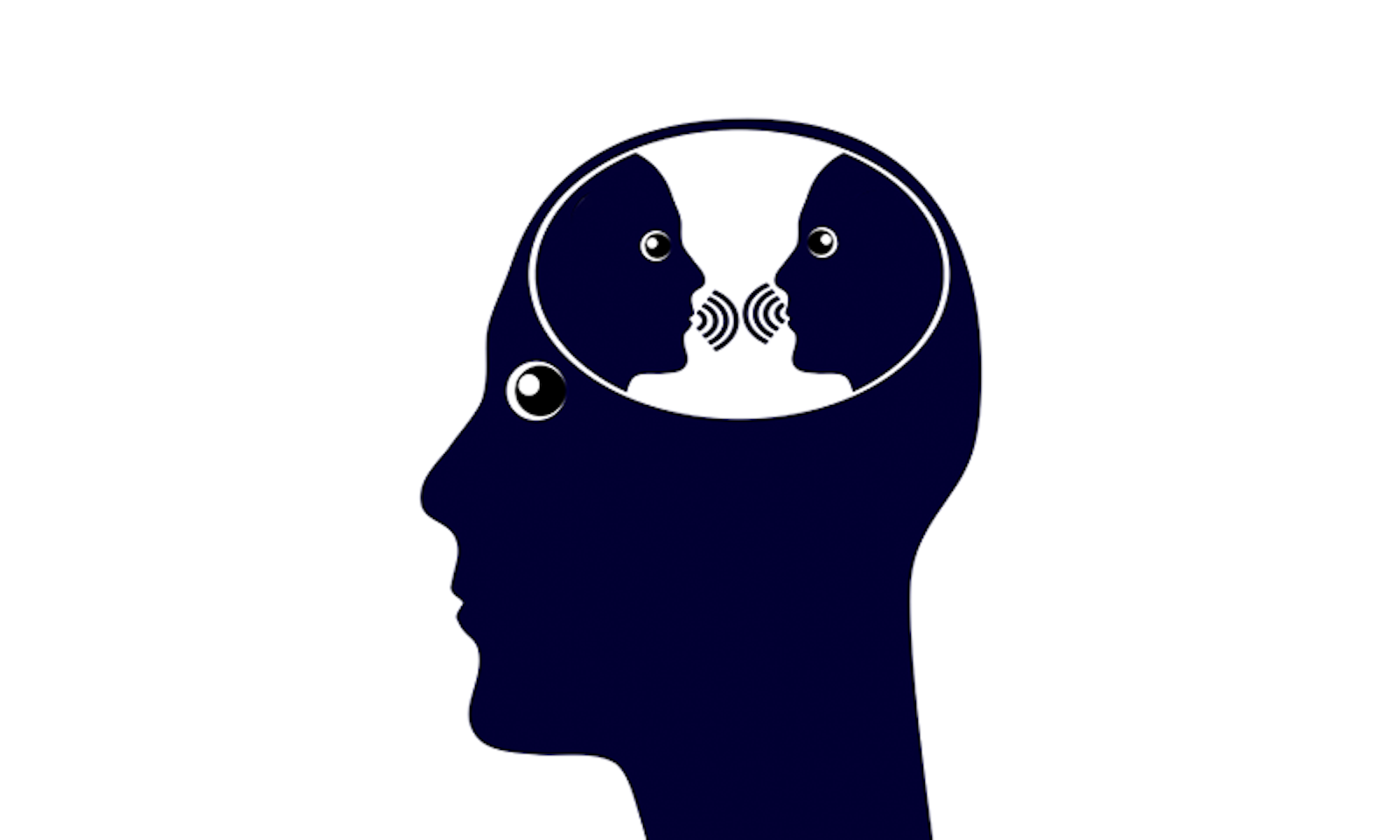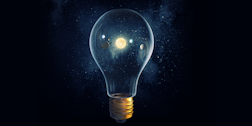One fine spring afternoon this year, as I was out running errands in the small Norwegian town where I live, a loud beep startled me into awareness. What had just been on my mind? After a moment’s pause, I realized something strange. I’d been thinking two things at the same time—rehearsing the combination of a new bike lock and contemplating whether I should wear the clunky white beeper that had just sounded into a bank.
How, I wondered, could I have been saying two things simultaneously in my mind? Was I deceiving myself? Was this, mentally, normal? I silenced the beeper on my belt and pulled out my phone to make a voice memo of the bizarre experience before I walked into the bank; aesthetics be damned.
I was in the midst of an experiment that involved keeping a log of my inner thoughts for Russ Hurlburt, a senior psychologist at the University of Las Vegas. For decades, Hurlburt has been motivated by one question: How, exactly, do we experience our own mental life?
My career in cognitive neuroscience didn’t prepare me for this.
It’s a simple enough question. And, one might argue, an existentially important one. But it’s a surprisingly vexing query to try to answer. Once we turn our gaze inward, the subjective squishiness of our mental experience seems to defy objective scrutiny.
For centuries, philosophers and psychologists have presumed our mental life is composed primarily of a single-stream inner monologue. I know that’s what I had assumed, and my training in cognitive neuroscience had never led me to suppose otherwise.
Hurlburt, however, finds this armchair conclusion “dramatically wrong.”1 Sure, it’s relatively common to experience “brain chatter,” those voices in our head that keep us up at night or haunt us with things we should have said. But Hurlburt’s research suggests that inner speech is not nearly as consistent, frequent, or even as universal as many of us might assume.2 He takes a much broader perspective on our inner lives, one that goes way beyond the contents of what we say to ourselves to include experiences that are hard to put words to at all.
Emerging from engineering school in the 1970s, Hurlburt decided to forgo a career in his field and instead take up psychology to pursue his growing obsession with how we experience the mind. The best way to try to capture the intangible aspects of inner life, Hurlburt reasoned, was to sample people’s thoughts at random times throughout the day—“in the wild” as he calls it. To that end he created oversized beepers that prompt wearers to make a note of what they were experiencing at the moment right before a beep. Soon after, they share their experiences—with him or with trained members of his team—in more detail through careful interviews.
I had written about Hurlburt and his long-running experiment before, and I was intrigued. So I decided to try the experience out myself. When my beeper arrived, I put appearances aside, donned the unwieldy contraption—complete with its dangling, wired-earpiece—and embarked on my own journey into my inner experience.
Over the course of a few months, I made notes on 54 random moments, and I spoke with Hurlburt about each one in detail during nine separate interviews, all lasting at least an hour.

Hurlburt calls his full approach Descriptive Experience Sampling.3 The process purports to reveal, in detail, the contents, forms, and nuances of our “pristine” inner experience. It requires considerable skill because there’s no ready vocabulary for the contents of inner life. Obtaining accurate descriptions requires being very delicate and careful not to unintentionally lead or persuade participants into a particular belief or assumption. Inner experiences can be dreamlike and elusive. They can include inner speaking, inner hearing, sensory stimulations, feelings, or even just a wordless sense of knowing or thinking something.4 Inside our heads, it seems, almost anything is possible.
According to decades of Hurlburt’s data from hundreds of participants, much of what we presumed about mental life appears incomplete—or just plain wrong.
Take fully formed inner speech, for example, which I had assumed made up much of my own inner life. As Hurlburt explained to me, “People come in thinking to themselves that they are talking to themselves all of the time.” On beeps where they reported inner speech he says, “I would ask them what exactly they are saying to themselves—a pretty reasonable, straightforward question. When they [consistently] can’t answer that question, they come to the conclusion, ‘Well, I wasn’t really talking to myself. I don’t really talk to myself.’” The DES data indicate that on average, inner speaking takes up only about a quarter of mental life.1
When I first started wearing the beeper, I was surprised that I often found it difficult to have any idea what my experiences were, even though they had just occurred. The beeper would go off at relatively mundane moments when there were no significant distractions: walking my dog, sitting at my desk, or eating lunch. Despite having the utmost enthusiasm for immediately describing the content of my inner life, only a moment ago, I found myself drawing complete blanks. Was my mind empty?
Perhaps it was. After slight embarrassment in revealing such inner vacancy, Hurlburt explained that although most participants are able to describe their experiences more easily, “There is no reason why there has to be inner experience at all.” At any wakeful moment, our brains are processing many things in parallel while skillfully keeping most of them out of our attentional focus—things like our body position, the temperature, the noise of an air conditioner. There is no reason why any one must be present in our experience.
As I got more practice with the beeper, I became more adept at identifying and describing my inner life. I began to see that my mind was often pursuing multiple avenues simultaneously.
I found myself drawing complete blanks. Was my mind empty?
One day a beep went off as I was eating lunch at home. In what seemed like an insignificant, ordinary moment, I realized I was having many different, disconnected inner experiences. I was contemplating what to make for dinner (yes, I like food) and was innerly beginning to say “I think I want …” hoping that an idea for a dish would suddenly spring into mind. At the same time, I was watching the bright leaves of a currant bush just outside a nearby window as they shook vigorously in the wind against the clear blue sky. What’s difficult to describe is that I also felt an awareness of the location of the bush relative to a cardboard box that had blown from my patio into a neighbor’s yard. I couldn’t see the box, but it drew my attention because I was planning to sneak into their yard to nab it before they noticed it. It’s difficult to describe the feeling, but the box felt somehow embodied with the leafy bush, and me. It was like a sense of the relevant, connective geometry.
As I reflected on this moment and the one by the bank where I caught myself with multiple simultaneous streams of inner speech, I realized they felt so strange because they challenge the common assumptions that mental life exists as a singular thread of experience5 and that multiple thought streams typically arise only during altered states of consciousness. The bank incident was even weirder because it comprised two experiences within inner speech. Unlike, say, an audio-visual experience of hearing and seeing someone speaking, for which our brains integrate multisensory information,6 the notion of innerly speaking multiple phrases at once is basically unheard of in established science.
After I revealed these odd experiences with slight uneasiness, Hurlburt quelled my apprehension by one-upping me. Without hesitation he averred that these simultaneous occurrences are not infrequent and, in fact, often have an uncanny spatial element to them. He explained that some, perfectly normal people attribute varied locations to inner voices. “People can have two different inner speeches going on at the same time; one ‘in the back of their mind’ and one in the ‘front’ of their mind, about two different topics at the same time and somehow keep those things straight,” he explained to me. “And inner voices don’t have to be in your head. They can be in your chest or outside of your body.”
Submitting to this research, I also learned that I frequently experienced a kind of opposite feat of inner speech—the “feeling” or apprehension of having just executed non-vocalized speech, but without words. The first instance occurred while I was sitting on my back deck, watching the shadow of a huge cloud front swiftly covering a nearby mountainside. As I watched a portion of the shadow sweep completely across a snow-covered region it moved onto a large, dark, rocky area, where I could no longer see it. At the moment just prior to the beep I felt a notion of “can’t see it anymore” but without actually saying those words in my head. Was it possible to conceptualize specific thoughts without having called upon language at all?
There’s no agreement on what “thinking” actually is.
By this point my mind was starting to be more open about the strange world of inner life. Hurlburt maintains that there are many ways to experience even something as seemingly straightforward as inner speech. “It’s possible to have a sense of having spoken, a sense of speaking, but without any words: So I feel myself to be speaking and I actually know what I’m speaking. I’m speaking ‘I can’t see it anymore,’ even though I don’t experience the words,” he explained.
What Hurlburt found unique about my experiences was that I often had difficulty distinguishing my own inner speaking from inner hearing. Although I had true inner hearing experiences such as a song “in my head,” which felt similar to actually listening to the song, these other instances were somehow different. I felt like I was hearing a voice that was clearly mine yet it was somehow more passively apprehended. It wasn’t like true voice hearing, though, where the heard voice can attribute its own, separate identity and agency.7 As odd as it sounds, the experiences were remotely comparable to listening to a narration of my thoughts. That is, I felt like the words were somehow coming to mind, rather than my actively constructing phrases, as when explaining something difficult and choosing my words carefully. Like now.
When you think a lot about thinking, it gets complicated. Even the term is more ambiguous than one might think (contemplative pun intended). Hurlburt explained that dictionaries define it as a cognitive thing whereas many philosophers and psychologists equate it with inner speaking. After listening in on the inner experiences of so many people over the years, Hurlburt finds each of these assumptions at once partially correct and partially misguided. “Thinking” is a tricky term, it turns out, and, just like “consciousness,” its definition depends on who you ask.
Hurlburt explained further that people often assume that others experience inner life similarly to themselves. But DES reveals that’s not the case. How people experience inner life can be as unique as they are. Someone who innerly speaks only seldomly but visualizes often might believe thinking is a visual thing. And so on with other forms of inner experience. So there’s no agreement on what “thinking” actually is, according to Hurlburt.
As the days logging and describing my thoughts went on, I had lingering questions about the deeply subjective aspects of this approach. So I called Alain Morin, a psychologist at Mount Royal University in Calgary, who also researches inner life. He and many other psychologists have long relied on questionnaires to understand phenomena like inner speech. Recent analysis has found these types of retrospective assessments to be relatively reliable for capturing patterns of self-talk, although not immune to the influence of bias and presupposition.8 They also leave out a vast swath of the inner experience that is difficult to put words to, such as the emotional tone of one’s inner voice or other vague sensations, like my moment gazing at the currant bush. Which is where, Morin contends, DES has much greater power of depth. “It’s probably the best method we have, short of wearing a brain recording device,” Morin told me. “But that’s science fiction, obviously, for now.”
Yet without such advanced technology, Hurlburt’s humble beeper prompted me to learn things about my own mind that even 45 years of existence and a career in cognitive neuroscience had kept hidden from my perception. Multiple speech streams, wordless speech, a strange geometric sense … I would never have known about these capabilities of the mind because my common assumptions about what consciousness is and how we experience it precluded these possibilities. It was at once dispiriting and wondrous to realize just how unaware we are of what our minds are doing almost all of the time. I now can start to imagine the vast oceans of potential experiences within our inner worlds—and the utter uniqueness of those to individual minds. And I owe it all to the awkward white beeper, which I am supposed to ship back to Las Vegas next week, but which I’m tempted to keep. ![]()
Phil Jaekl is a freelance science writer and author with an academic background in cognitive neuroscience. His latest book is Out Cold: A Chilling Descent into the Macabre, Controversial, Lifesaving History of Hypothermia. He lives in the Norwegian Arctic in Tromsø.
Lead image: Sangoiri / Shutterstock
References
1. Hurlburt, R.T., Heavy, C.L., & Kelsey, J.M. Toward a phenomenology of inner speaking. Consciousness and Cognition 22, 1477-1494 (2013).
2. Krumm, A.E. & Hurlburt, R.T. A complete, unabridged, “pre=registered” descriptive experience sampling investigation: The case of Lena. Phenomenology and the Cognitive Sciences (2021).
3. Hurlburt, R.T. & Heavy, C.L. Exploring Inner Experience John Benjamins Publishing Company, Amsterdam, Netherlands (2006).
4. Hurlburt, R.T. & Akher, S.A. Unsymbolized thinking. Consciousness and Cognition 17, 1364-1374 (2008).
5. Fernyhough, C., Alderson-Day, B., Hurlburt, R.T., & Kühn, S. Investigation multiple streams of consciousness: Using descriptive experience sampling to explore internally and externally directed streams of thought. Frontiers in Human Neuroscience (2018).
6. Jaekl, P., Pesquita, A., Alsius, S., Munhall, K., & Soto-Franco, S. The contribution of dynamic visual cues to audiovisual speech perception. Neuropsychologia 75, 402-410 (2015).
7. Larøi, F., et al. The characteristic features of auditory verbal hallucinations in clinical and nonclinical groups: State-of-the-art overview and future directions. Schizophrenia Bulletin 38, 724-733 (2012).
8. Racy, F., Morin, A., & Hagerty, J. Concurrent validity and reliability of representative inner speech questionnaires. Psychological Reports0, 1-8 (2022).



















